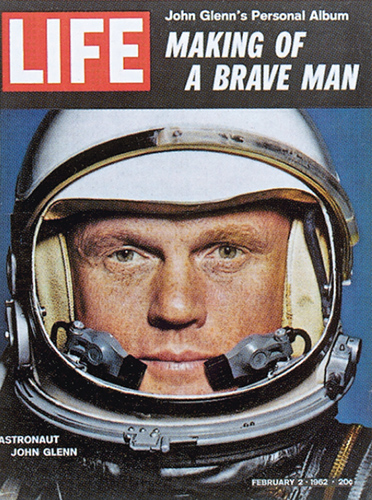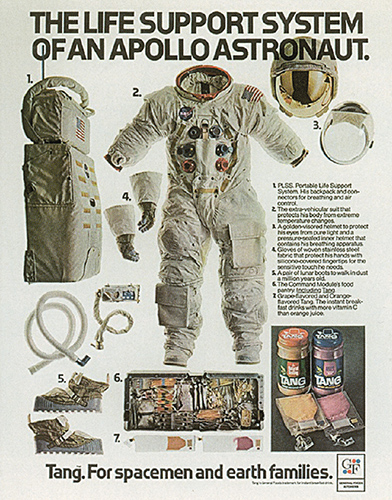
This Article From Issue
November-December 2014
Volume 102, Number 6
Page 470
DOI: 10.1511/2014.111.470
MARKETING THE MOON: The Selling of the Apollo Lunar Program. David Meerman Scott and Richard Jurek. xiv + 130 pp. MIT Press, 2014. $39.95.
It was one of the smallest incidents of the Apollo program. It was also one of the most telling. On August 2, 1971, just before departing the Moon, Apollo 15 commander David Scott set down an unauthorized 8.9-centimeter aluminum figurine called Fallen Astronaut, a memorial to the American and Soviet explorers who died in the pursuit of the space race. The following spring, the art gallery representing the sculpture’s creator announced plans to offer a series of replicas. Around the same time, word leaked that the Apollo 15 crew had brought back 100 stamped envelopes “postmarked” on the Moon and sold them to a German collector.

From Marketing the Moon.
The astronauts had nothing whatsoever to do with the replica sculptures; indeed, Scott was outraged when he learned about them. And the princely fortune fetched by those stamps? Three $7,000 payments, to be placed in trust funds for the Apollo 15 astronauts’ children—a pittance compared to the $500,000 from Life magazine that the original seven Mercury astronauts reportedly shared, with NASA’s blessing, in exchange for exclusive access to their personal stories. This time around, though, the mood was ugly. Congress held an angry closed-door inquiry. Reporters wrote outraged stories about the perceived profiteering.
Something profound had changed since the early days of the heroic, untouchable space heroes. In Marketing the Moon, David Meerman Scott (no relation to NASA’s David Scott) and Richard Jurek do a masterful job defining that something and placing it within a much broader exploration of how the U.S. space program acquired such mythic status in the first place—before it abruptly, sadly crumbled away. Along the way, the authors achieve something I doubted was possible: They provide fresh and important insights into the Apollo program, nearly half a century after the fact.
The story of Fallen Astronaut fills but a single page of their account, which gives you a sense of the breadth of the material here. Even more than its scope, Marketing the Moon’s focus is what makes it stand out. Instead of homing in on the science or technology of getting to the Moon (although the book contains plenty of both), it dissects the crucial yet far less familiar public relations and marketing effort behind one of the signature achievements of the 20th century. The authors bring plenty of insider credentials. Scott is a marketing strategist and consultant and Jurek is the president of Illinois-based Inland Marketing and Communications; equally significant, both are obsessive collectors of space artifacts and memorabilia.
Public fascination with space travel long predated the Apollo program, and it served as a launch pad for the program’s ultimate success. A full century earlier, Jules Verne had described a fictional lunar voyage in From the Earth to the Moon, which Neil Armstrong cited in detail in his final television transmission from Apollo 11. During the 1920s and 1930s, Robert H. Goddard pioneered the principles of rocketry and also grappled with the challenge of controlling the public reporting of his sensational experiments; NASA’s Goddard Space Flight Center in Maryland is named in his honor. Scott and Jurek briskly track these early developments, along with colorful and less familiar episodes, such as the uneasy alliance between Wernher von Braun—the ex-Nazi brain behind America’s rocket program—and Walt Disney. (Although he retired from NASA before the launch of Apollo 17, the last of the Apollo missions, von Braun's influence extended much longer, into the era of a vehicle "popularly known as the space shuttle." He discusses the shuttle—which he notes "will be the first true 'aerospace' vehicle in that it can fly and maneuver in both space and the atmosphere"—in his November 1972 article for American Scientist, "The Reusable Space Transport.")
With von Braun’s assistance, Disney created a three-part series depicting “Man in Space,” exploiting the newly mainstream medium of television. In the mind of the American public, the hugely popular Disney–von Braun collaboration, which ran between 1955 and 1957, cemented the idea of space travel as a near-term plausibility. (At one point, Russian space scientists asked to borrow a copy of the show, hoping to inspire their colleagues as well, and Disney refused. The problem was not that they were communists, according to Scott and Jurek; it was that the Russian government had earlier mishandled a loaned print of Snow White, and Disney held a grudge.) “When the launch of Sputnik 1 shocked the world, marking the dawn of the space age,” the authors write, “the United States was far better equipped for the challenge ahead than it realized.”
From there, Marketing the Moon dives into the thick of the story: the 1958 creation of NASA as a civilian—rather than military—agency and the attendant need to sell its message directly to U.S. voters. From the start, NASA recruited PR workers with journalism backgrounds and set them up to operate “not as pitchmen but as reporters,” in the authors’ words. That blurring of lines continued throughout the 1960s, as NASA offered technical briefings in advance of missions and opened media access to its labs as well as to its employees’ lives.
NASA's high-wire PR act worked spectacularly well so long as the agency's message and the nation's mood were closely aligned.
As the popularity and visibility of the manned space program mushroomed, NASA’s many contractors and vendors got in on the act as well, albeit in predictably more commercial ways. NASA may not have been pitching, but the makers of Rolex watches and Stouffer’s frozen dinners certainly were. “Everybody who’s been to the Moon is eating Stouffer’s,” proclaimed one ad. Scott and Jurek’s sideline as space collectors is highly visible throughout the book, as the pages are crammed with rarely seen artifacts, ads, and photographs that capture the space culture of the 1960s. (Marketing the Moon is also thoughtfully footnoted but inexplicably lacks an index.)
NASA’s high-wire PR act—a decade-long campaign to keep America obsessed with a costly, dangerous, wildly ambitious shared adventure—worked spectacularly well so long as the agency’s message and the nation’s mood were closely aligned. The assassination of President John F. Kennedy barely a year after his famous “we choose to go to the Moon” speech, along with the omnipresent threat of humiliation by the Soviets, kept the NASA mystique vibrant even through the tragic February 1967 Apollo 1 fire that killed three astronauts during a launch rehearsal.

From Marketing the Moon.
Meanwhile, the relationship between NASA and television, always important, became downright symbiotic. Scott and Jurek quote Don Hewitt, president of CBS News: “If television brought you distasteful things like race riots and a war we couldn’t win, it also brought you the astronauts. It was a chance for television to show that it, too, had the right stuff.” To feed the media beast, NASA expended much effort developing the compact, reliable TV camera that went to the Moon with the Apollo 11 crew and showed the world the first, now legendary human footsteps on another world.
Then came the Change. All of NASA’s marketing and publicity—not to mention nearly all of its scientific and engineering energy—had been devoted to the solitary goal of putting a man on the Moon “by the end of the decade,” as Kennedy had promised. Once the prize was attained, NASA became just another agency spending money, and astronauts became more government employees doing their jobs. In reality, polls show that support for space exploration “was neither widespread nor very deep” all through the 1960s, the authors note. What Americans had supported was completing an awesome challenge and, in doing so, beating the Russians. After Apollo 11, no amount of marketing muscle could reinvent that consensus.

From Marketing the Moon.
Oh, NASA tried. Engineers kept improving the quality of the video cameras, hoping to keep television audiences riveted, to little effect. During Apollo 12, astronaut Alan Bean accidentally pointed the camera toward the Sun and burned out its image processor, terminating the video feed from the Moon. TV networks, forced to cut away, discovered that audiences didn’t care. NASA’s golden moment was over. By the time of Apollo 15 and Fallen Astronaut, President Richard Nixon had already canceled the planned Moon missions 18 through 20, and it was clear that most of NASA’s grandiose follow-up proposals described missions that would never occur.
Throughout their account, Scott and Jurek are evenhanded and meticulous in chronicling NASA’s efforts—sometimes naive, occasionally manipulative, always heartfelt—to make the Apollo program into a national movement. At the end of Marketing the Moon, I hoped for some follow-on analysis about what has happened to NASA since Apollo and about how the agency might build a new consensus for human exploration of space. The authors don’t do that, and on reflection I understand why. The great strength of their writing is its emphasis on documentation over didacticism.
Marketing the Moon follows the ad-world dictum that NASA itself failed to heed: Always leave ’em wanting more.
Corey S. Powell is consulting editor at American Scientist, founder of the blog Out There (http://blogs.discovermagazine.com/outthere), and an avid writer about all things space.
American Scientist Comments and Discussion
To discuss our articles or comment on them, please share them and tag American Scientist on social media platforms. Here are links to our profiles on Twitter, Facebook, and LinkedIn.
If we re-share your post, we will moderate comments/discussion following our comments policy.